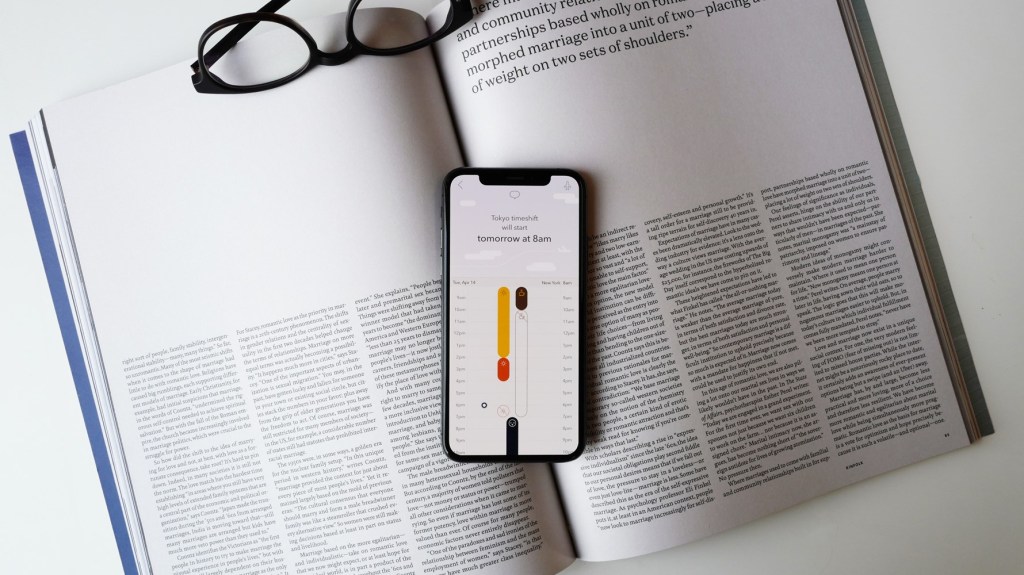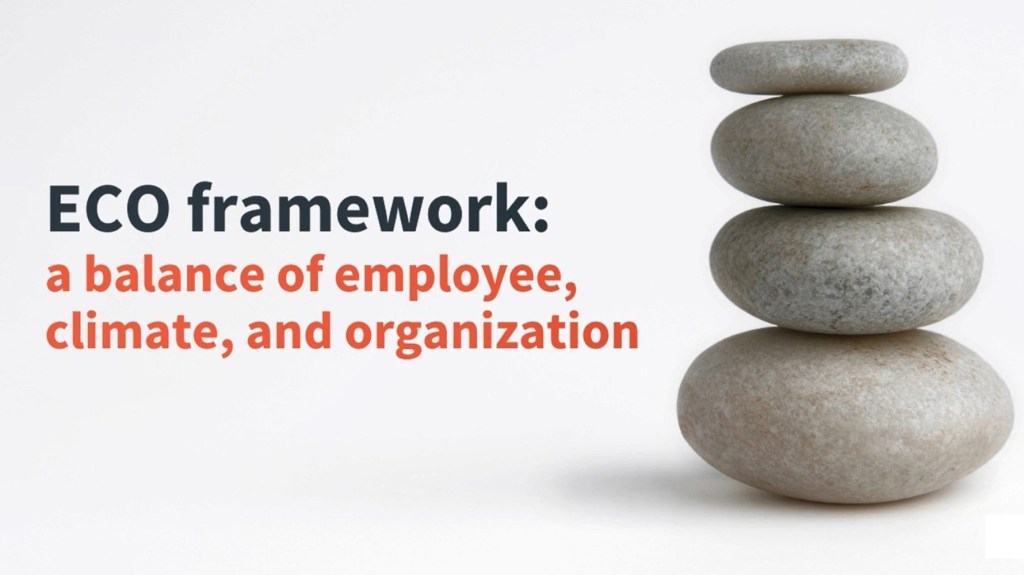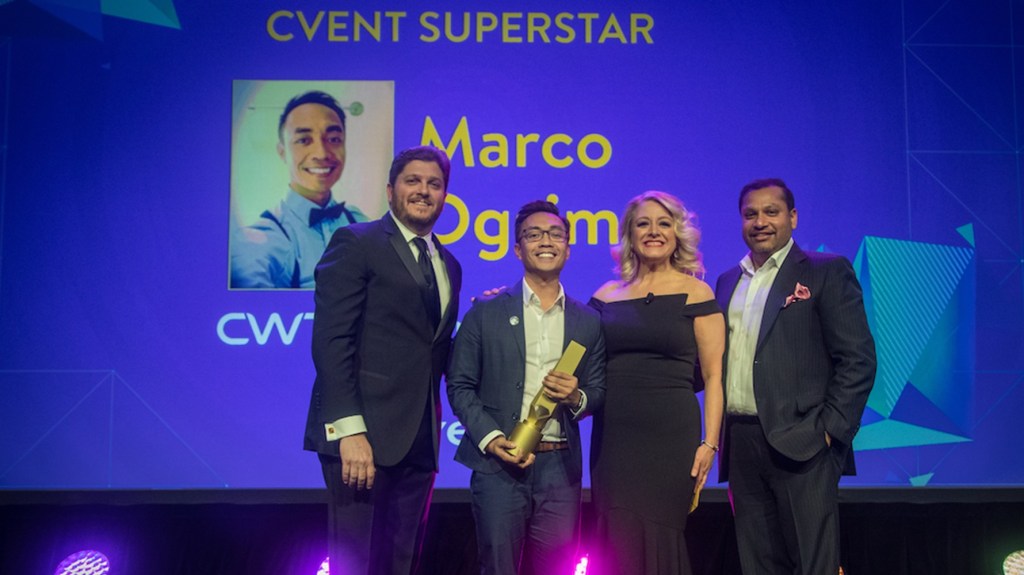Introducing the latest myCWT product and service enhancements
Building on our digital, omnichannel myCWT platform, our new products and services will simplify travel management for you and your employees – anytime, anywhere, anyhow.
Note: Featured services may not be available in your country at this time. Please reach out to your CWT representative for more details.
Hear from Chief Product Officer, Erica Antony as she shares the key product highlights of 2024, along with the key areas driving innovation.
-

2040: Baseline, Boom or Bust
As we enter an era of rapid transformation and unprecedented challenges, it is essential for travel managers, meeting & event planners, and corporate decision-makers to look ahead and frame our current strategic thinking with a clear vision of the future. Business travel and meetings and events (M&E) are poised for significant change over the next decade and a half, driven by a complex interplay of sustainability goals, technological advancements, evolving work models, and geopolitical dynamics.
In this paper to mark the 10th anniversary of our Global Business Travel Forecast, we explore, for the first time, a long-term vision of the future and potential trajectories through three distinct scenarios, each offering insights into how these forces should affect policy-making, budgeting and priorities. By examining these scenarios, we can better understand the diverse possibilities that lie ahead and the strategic imperatives required to thrive in each potential future.
Based on trajectory data analysis and interviews with industry leaders, behaviorists and climate tech founders, this forward-looking approach enables us to anticipate changes, strengthen our strategies, and make informed decisions that align long-term objectives. It is through this lens of foresight and adaptability that we can build resilience, seize opportunities, and navigate the complexities of the future.
We invite you to reflect on the insights presented, and consider how your organization can prepare for the opportunities and challenges that lie ahead. Together we can ensure that travel and meetings remain catalysts for growth, scalability and sustainable practices.
- Scenario development is both an art and a science
- Megatrends Shaping the Future of Business Travel, Meetings and Events
- Sustainability goals the new crux of corporate policy
- Technology Revolutionizes Travel Management
- Modern work models spark new travel patterns
- Changing demographics open doors to new opportunities
- Three Scenarios: Base case, boom and bust
- Future-proofing strategies

-

CWT GBTA Global business travel forecast 2025
When it comes to pricing, global business travel has finally reached an enduring, higher baseline. Prices will continue to rise in 2025, but only moderately, so expect a period of normalized growth.
However, this pricing environment, one of marginal gains and price regularity, is fragile. Global leisure travel has now realized a lot of its pent-up demand, while corporate travel has been resurgent, with 2024 edging at preCovid levels.
There are many factors at play, whether its volatile oil prices, labor costs and constraints, inflationary pressures, and geopolitical factors. As this elevated baseline edges upwards, albeit marginally, travel budgets will come under increased scrutiny, especially as travel patterns and attitudes change.
It’s why business travel can’t be viewed in a silo, and the true value to an organization must be fully realized. This forecast can help with those calculations.

-

Capitalize on emerging technologies in corporate travel
Technological advancements are accelerating at an unprecedented pace. How will emerging innovations like Generative AI, blockchain, and self-sovereign identity (SSI) transform corporate travel?
BTN and CWT probed global CEOs, travel managers, industry consultants and tech experts on the promises, questions, and expectations these innovations raise and how they are set to reshape traveler experience, cost control and service delivery in corporate travel and events.
Download and discover
- The technologies that will have the greatest impact on corporate travel in the next 2-5 years
- How these emerging technologies are poised to control costs, enhance service and security, and boost efficiency
- The critical challenges, opportunities, risks and roadblocks each innovation raises
- What travel managers, buyers and experts anticipate from these innovations

-

The sourcerer: How to harness the magic of a ‘do-it-yourself’ small meetings strategy
Anyone else feel like the meetings and events industry is having a moment? Navigating this new normal for our industry has been challenging but above all else, it has been changing. We are implementing programs for our customers that – pre-pandemic – would have been lower priority on the list of enhancements. Things like virtual and hybrid strategies. Not just hosting one or two virtual meetings but creating a common-sense solution within a client’s greater meetings program that bring engagement opportunities beyond face-to-face experiences. We are also seeing increased demand for solutions and strategies that finally zero in on the evasive “small/simple meetings” unicorn scenario.
Before the pandemic you could probably find dozens of examples of comprehensive meetings and events programs that outline a process or strategy for small and simple meetings. Today we are seeing hundreds more ready to not just have the conversation but implement a strategy and tool to harness all the magic of rapid technological development during the pandemic. DIY or self-service tools that can be operated through multiple devices now make finding meeting space anywhere, a breeze. More importantly, the tools are more powerful than ever and are becoming a differentiator in strategic venue sourcing programs.
Our customers are finding that they have had to pivot within their organization due to fewer people coming into the office. Pre-pandemic, in NYC for example, more than 95% of the workforce worked in person at their office, according to research by The City. Today that number sits at 30%. That is a huge decline and is forcing companies to think differently about procuring meeting space – whether it be for an internal team meeting for a few hours or a multi-day customer session, finding a venue in a location that meets the needs of the new office worker and their customers and clients, is changing.
How to adapt your sourcing strategy to changing behavior
Meetings are now happening closer to workers’ and their customers’ homes and it’s not just their day-to-day work location that has changed. We are seeing overall meeting behaviors change. The average number of attendees for smaller meetings has decreased 42% from 19 in 2019 to 11 in 2022 according to venue booking Meeting Package. Additionally, lead time has decreased 41% from 43 to 20 days. These numbers create a common- sense case to make sure that your strategic sourcing program is ready to support and capture those growing requests.
This means that not only will strategic sourcing programs need a sound strategy to help navigate meeting owners to services that align with their needs – but they will also need that DIY tool which makes booking those meetings simple. If they have a small meeting that doesn’t require complex sourcing and has low financial risk, there should be an easy solution for that meeting owner to get the space they need without jumping through a lot of hoops and it keeps them compliant. The holy grail for planners.
With diverse locations, technology, and budgets, finding the right tool needs careful consideration. It’s got to be mobile, reliable and enable direct booking for quick transactions. It should also be flexible, and implementation should not create turmoil within. Cost for some tools can be sizeable so do your homework my friends.
The ability to capture the smaller meetings activity through a DIY sourcing tool reveals critical information about spend that can provide incremental savings and increased leverage from meetings you otherwise wouldn’t see. This is the unicorn all sourcing programs are looking for! It allows procurement and travel managers to capture the activity and spend for those meetings without dedicating precious internal resources to source or solve for the procurement of them. And let’s face it, resources are more precious than ever so it’s important that whatever strategy is in place – it maximizes resources, not drains them.
Change is a constant
It’s safe to say that we are all riding the wave of discovery as the meetings and events landscape continues to change. Our ability to change with it will be the key to not just surviving but winning. Winning means bringing programs forward despite the current environment and taking advantage of the moment that this industry is having. Winning means finally bringing the unicorn that is a small meetings solution to your program and make it a reality that starts paying your program back instantly with visibility, savings, and most importantly, addresses the new normal that workers are facing today.
Discover our small meetings booking tool
Image credits: Adobe Stock
-

Jet lag is history
You lie awake in a bed that’s not your own, in a strange place, unable to sleep. You struggle to keep your eyes open during the key business meeting in which you are expected to close a deal critical to your quarterly quota.
You’ve done all the ’right‘ things recommended in a recent blog post, paid more for a better seat so you could sleep in comfort on the plane, set your watch to local time, struggled through your normal 7am jog, and selected the right pillow from the hotel’s sleep program.
The jet lag science we have all missed
Jet lag is caused when our internal circadian clock is disrupted – our sleep/wake and light/dark cycles shift too quickly for our circadian clock to keep up. Before jet travel, humans were incapable of moving through several time zones in a matter of hours, but with jet travel we do, and our bodies have not evolved to cope.
The problem is that few understand the real science of jet lag, and we do all the wrong things to reduce the symptoms of jet lag. Surprising to many, light cues – not sleep, exercise, food, or caffeine – are the only way to naturally reset the clock and address jet lag. The precise timing of when to see light and when to avoid light is the difference between a successful trip or a miserable one. Timing is everything when it comes to jet lag and doing things at the wrong time can shift your rhythms in the wrong direction, making your jet lag worse.
Once you know the science, you can get the timing right
So how can we speed up our circadian clock’s adaptation to a new time zone? Timed light exposure – and to a lesser extent the right type and dose of melatonin supplement, at the right time – can shift the circadian clock quickly to new time zones.
Watch Timeshifter’s Chief Scientist, Dr. Steven Lockley, explain jet lag science. Dr. Lockley is a renowned expert in circadian rhythms, sleep, and jet lag. He has spent 25 years studying sleep and works with clients such as Formula 1’s elite and NASA.
Timing is everything
The challenge is to find the right timing for when to see and avoid light, take melatonin, sleep or nap, and use caffeine effectively. Solving this challenge is deceptively complicated, and can only be determined based on your sleep pattern, chronotype, and itinerary. One solution that can help with timing everything correctly is the Timeshifter jet lag app. Timeshifter was developed with world-renowned scientists, based on the latest research in sleep and circadian neuroscience. The algorithm behind the app has helped astronauts manage traveling the world to keep up with their non-stop training schedule. This same algorithm is used by Formula 1 racing drivers and Olympic athletes so they can perform at their best when traveling.
Watch Timeshifter’s Chief Scientist, Dr. Steven Lockley, explain jet lag science. Dr. Lockley is a renowned expert in circadian rhythms, sleep, and jet lag. He has spent 25 years studying sleep and works with clients such as Formula 1’s elite and NASA.
The costs of not addressing jet lag are expensive and harmful
Jet lag can be expensive. Think about it: You might spend thousands of dollars to upgrade to business class for an important work trip. Your time at the destination is expensive and valuable too – you might even check-in to a high-end hotel to get the best sleep experience. That money is wasted, however, if you don’t get the benefits of the upgrade and sleep and see light at the wrong time. Regardless of what you spend, without shifting your circadian rhythm properly, your time at your destination will be marked by fatigue, lack of focus, reduced productivity, increased errors, and other costs. And when you arrive back home, you won’t be ready for your role as a mom/dad or husband/wife, or to start work Monday morning.
It’s not just about sleep and productivity. There are circadian rhythms in the immune system, reproductive hormones, heart and lung function, digestion, and metabolism. Gastrointestinal disruption is a common complaint in jet lag, most likely due to disruption of peripheral clocks in the stomach, pancreas, liver and intestine. Regular travelers might put themselves at increased risk of diabetes, heart disease, and some cancer as has been shown for shift work, which poses similar challenges to circadian synchrony.
More than half a century into the jet age, jet travel is no longer a novelty; we take its advantages for granted, and have begun to notice and understand some of its previously hidden costs. But there is good news for the almost half a billion annual long-haul travelers: The science of jet lag is finally coming to the fore.
-

Podcast: A green standard in hospitality
Belinda Hindmarsh, Chief Growth Officer of global travel management platform CWT is joined by Kit Brennan, Co-founder and Director of award-winning carbon intelligence platform Thrust Carbon. Together they have decades of experience in the travel tech space. CWT recently became the first major global TMC to activate point-of-sale emissions data with Thrust Carbon, answering the industry’s call-to-action to reduce our impact on the planet by enabling travelers to make the most eco-friendly decision when booking a trip.
In this episode Belinda and Kit turn their sights on the hotel industry which is infinitely more complex than air travel when it comes to measuring sustainability.
Find out:- Whether there are sufficient measures that accurately determine a hotel’s green credentials like-for-like, as accurately as air.
- What the industry needs to do to provide greater transparency.
- Should the onus fall on governments, hoteliers or travelers?
- Is it gross to not have your bath towels laundered?
[buzzsprout episode=’10678895′ player=’true’]
-

7 life lessons from Star Wars
It may be pseudo-psychiatrics to try and read deep meaning into science fiction movies, but Star Wars offers many insights into core narrative traits from which we can all benefit in real life – and here are my magnificent seven (interestingly another film which has attracted mindful speculation over the years, but let’s leave that for another blog.
1. Be open to new possibilities
“We are the spark that will light the fire, that will burn the First Order down,” says Poe Dameron in the Last Jedi. Effectively he’s saying that small actions have wide reaching ripples that impact across much bigger areas – so we should never give up.
2. Hope springs eternal
Through Jyn Erso’s theft of the Death Star’ blueprints the one and only weak spot in its defences can be identified, and, as she puts it: “We have hope. Rebellions are built on hope.” Hope is the common theme uniting all the movies.
3. Loyalty matters most
When the Resistance is faced with hopeless odds in the Rise of Skywalker, they are reminded by Lando Calrissian how the Rebels originally overthrew the Empire: “We had each other. That’s how we won.”
4. Just be yourself
Traditional wisdom wisdom delivered by Princess Leia: “Never be afraid of who you are.”
5. It’s never too late to change
Whether in yourself, your colleagues, or your ambitions. As Yoda so explicitly puts it: “Do. Or do not do. There is no try.”
6. Focus creates a sense of perspective
When Rose Tico utters her final line in the Last Jedi: “That’s how we’re gonna win. Not fighting what we hate, but saving what we love,” she removes the what and elevates the sense of why.
7. Different traits can make the best bedfellows
For some the Force can be used for good, for others it is for evil, and for others still it is about hope. No matter what drives the Star Wars characters, it takes many different types to restore order and balance to the galaxy. Worth bearing in mind what Obi-Wan Kenobi actually says in the story: “The Force will be with you, always.”
For those interested in movie trivia, the phrase “May the Force be with you” was uttered twice in the movie series, once by General Dodonna as he ridiculed the Rebels for preparing their Death Star attack, and once, ironically, by Han Solo to Luke Skywalker.
For everyone else, let’s just say: “May the fourth be with you.”
-

Target practice: 3 ways to achieve your company’s sustainability targets
Our recent survey of our clients, validated by a number of follow-up discussions, indicates that sustainability is a top priority across virtually our entire client base. Many of the travel managers feel that travel is or could be at the leading edge of their companies’ sustainability initiative and are well on their way implementing their programs while some are in earlier stages of program definition. CWT can help regardless of what phase our clients are in their sustainability programs.
CWT has provided sustainable data and reporting for over a decade, and was recognized by EcoVadis with the highest sustainability rating for two consecutive years which puts CWT in the top 1% of 75,000 companies reporting.
We’re seeing a marked shift in priorities, “Customers are demanding more sophisticated and accurate sustainability tools and solutions, which they find necessary to align their travel programs with corporate goals and initiatives,” says Charlie Sullivan, CWT’s Head of Product Management, Travel Management Portfolio. Here are three ways to help realize your sustainability ambitions.
- Influence choice at the point of sale – In talking to our global customer base late last year, we found that 87% wanted information at point-of-booking to help reinforce responsible travel choices. The tech and tools needed to make the right choice at the time of booking are critical to success, and ultimately align travel programs with corporate goals and values. Find out more about point-of-sale carbon indicators.
- Track, report, rinse and repeat – Work with your travel management company to analyze booking trends and emissions data to enable you to make changes fast and at scale.
- Integrate sustainable travel into the overall performance of your program – Modelling employee wellbeing, alongside climate impact, and organizational performance is something our customers see as an imperative to garnering employee adoption. Most organizations measure ‘cost for profit’ and ‘carbon for planet’, leaving out any consideration around the impact travel can have on an employee. Since October 2021, 90% of engagements with CWT’s ECO consulting framework focused entirely on balancing employee satisfaction with greener travel.
Hear from Charlie Sullivan about how CWT collaborates with tech partners like Amadeus to help clients achieve their sustainability goals
- Influence choice at the point of sale – In talking to our global customer base late last year, we found that 87% wanted information at point-of-booking to help reinforce responsible travel choices. The tech and tools needed to make the right choice at the time of booking are critical to success, and ultimately align travel programs with corporate goals and values. Find out more about point-of-sale carbon indicators.
-

10 jet lag myths debunked
Sleeping poorly on a work trip may seem insignificant, but the consequences of jet lag are wide-ranging and costly. From making more mistakes, missing opportunities, and low productivity to disruption of our immune function, compromised safety, and less personal time.
Jet lag is caused when our internal circadian clock is disrupted — our sleep/wake and light/dark cycles shift too quickly for our circadian clock to keep up. Before jet travel, humans were incapable of moving through several times zones in a matter of hours, but with jet travel we do, and our bodies have not evolved to cope.The only way to dramatically accelerate adaptation to new time zones is managing when you see and avoid light. The right light exposure at the right time can significantly accelerate your adaptation. Seeing light at the wrong time will make your jet lag worse. Melatonin supplements can speed up adaptation but only if you take the right type and dose, at the right time, along with correctly scheduled light exposure.
Jet lag myths
With this in mind, Timeshifter’s Mickey Beyer-Clausen looks at some of the many persistent misconceptions about how to alleviate jet lag circulating via magazines and blogs — many are even kept alive by the travel industry.
- Myth 1: “Sleep as much as possible on the plane”
If you sleep at a time when you should be exposing yourself to light, you will end up shifting your body clock in the wrong direction and make your jet lag worse. - Myth 2: “Use sleep medications”
Pills such as Valium or Ambien can be so easy and tempting to use to get some sleep in a noisy plane or in a hotel, but they do nothing to shift your internal circadian clock – and even worse, may lead to you missing your chance to see light at the correct time. - Myth 3: “Use massages or acupuncture”
As pleasant as they may feel, neither massage nor acupuncture have been shown in any properly conducted study to affect your circadian clock.
- Myth 4: “Try special diets”
Countless unqualified “wellness gurus” will claim that fasting or fancy diets can alleviate jet lag, and it’s simply not true. The few studies that have purported to show that fasting can shift the circadian clock have been done on rodents – which are nocturnal animals and inappropriate for the study of humans, who are diurnal (active during the day). - Myth 5: “Take a morning run”
While regular exercise can help with regulating your sleeping patterns in normal life, exercise is a very weak circadian clock synchronizer so it doesn’t help reset your circadian clock. Also, 7am in your new time zone could be 2am in your circadian clock, making this a terrible time to exercise. - Myth 6: “Trust airplane lighting”
New forms of LED lighting may be far more sophisticated, and aircraft manufacturers and plenty of airlines insist they will help you with jet lag. However, any lights in an aircraft can subject you to light at the wrong time, and this will make your jet lag worse. - Myth 7: “Travel in business class”
Spending that extra bit of cash for a comfortable seat (or even a bed) to help you sleep during a flight can be extremely appealing – especially if it means you can be ready to hit the ground running and head into work or an important meeting when you arrive. Go ahead and splurge for the bed if you can – but make sure you sleep at the correct times to properly prevent jet lag. - Myth 8: “Stay at five-star hotels”
Investing in a plush hotel room with expensive and luxurious mattresses, pillows and bedding can indeed be tempting – but just as with business class, this won’t address your jet lag unless you time light exposure correctly and sleep at the appropriate times. - Myth 9: “Stay hydrated”
Though it’s important to stay hydrated and drink enough water in general, there is zero evidence it can have any impact on your circadian clock. - Myth 10: “Power through with lots of caffeine”
Many have given up on jet lag, and just use a lot of caffeine to survive. Although caffeine doesn’t shift the circadian clock, it can help mask the symptoms. Just be careful not to use it eight hours before sleep as it can make it difficult to fall asleep and disrupt your sleep quality.
Timing is everything
The challenge is to find the right timing for when to see and avoid light, take melatonin, sleep or nap, and use caffeine effectively. Solving this challenge is deceptively complicated, and can only be determined based on your sleep pattern, chronotype, and itinerary. With the Timeshifter jet lag app, you can create personalized jet lag plans with all of this in mind.
- Myth 1: “Sleep as much as possible on the plane”
-

CWT strengthens finance and strategy leadership team capabilities
CWT, the Business-to-Business-for-Employees (B2B4E) travel management platform today announces three new leadership positions, pivotal to supporting the successful delivery of CWT’s financial and strategic priorities. Jim Shepherd joins CWT as Senior Vice President, Corporate Finance, Lisa Papageorge is confirmed as Vice President Treasurer, having held this role on an interim basis since joining the business in February 2022, and Julia Kou is appointed to the newly created role of Senior Vice President, Chief Strategy Officer. All appointments are effective immediately and report directly to Bill Courtney, CWT’s EVP & Chief Financial Officer.
“We’re extremely proud to have such immensely talented and experienced leaders, who individually and collectively bring a powerful dynamic to our organization, as we continue to execute on our growth initiatives, scale our operations and uphold our leadership position in the business travel sector,” said Bill Courtney, Chief Financial Officer. “Their experience across a wide range of financial, treasury and strategy matters, further strengthens our finance and strategy team.”
Based in Minneapolis, Jim Shepherd will serve on CWT’s Finance & Strategy Leadership Team and be responsible for the delivery of analysis, decision support, and leadership of Financial Planning and Analysis as well as the Finance Business partnerships to the global operating functions of CWT. Jim brings more than 20 years senior leadership experience in the areas of finance, strategy, and operational excellence, delivering shareholder value and strategic impact for Fortune 500 companies. He joins CWT via Medtronic, where he served as the Vice President of Strategy and Transformation for Global Operations and Supply Chain.
Dallas based Lisa Papageorge, has served as a prominent member of CWT’s Finance & Strategy Leadership Team since the start of the year, successfully overseeing CWT’s treasury and investor relations organization. Before joining CWT, Lisa was Treasurer at Service King Collisions Repairs, where she was responsible for the company’s implementation of cash management programs. Prior to that, she spent over six years at Dr Pepper Snapple Group where she led the global treasury function, cash flow management, and banking relationships.
Following her appointment as Head of Strategy, Planning & Analytics in 2020, Julia Kou has been responsible for the effective alignment of CWT’s strategic plans to its investments, whilst overseeing corporate planning, pricing & profitability, and business insights functions. In her new role, Julia will be dedicated to leading corporate strategy, mergers & acquisitions, strategic transactions and business insights & analytics. She will continue to collaborate with the Executive Leadership Team to enable CWT’s company’s vision and strategic priorities.
CWT is a leading global partner in business travel, meetings, and events. Operating across six continents, we deliver sustainable, tailored solutions that help organizations connect, engage, and thrive in an evolving world. Our myCWT platform integrates advanced technology with human expertise to simplify travel and enhance traveler and attendee experiences. Extensive global coverage, seamless data integration, AI-driven analytics, and carbon-conscious travel tools enable businesses to optimize their travel and meetings programs while delivering measurable value.
With 150 years of industry experience and a deep commitment to partnership, CWT collaborates with clients to shape the future of business travel and events, making them more efficient, responsible, and impactful.
-

CWT Appoints Patrick Andersen as Chief Executive Officer
CWT, the Business-to-Business-for-Employees (B2B4E) travel management platform, announces that Michelle McKinney Frymire has decided to step down from her roles at the Company. As part of the Company’s long-term succession planning process, the Board of Directors has appointed President and Chief Commercial Officer Patrick Andersen as its next President and Chief Executive Officer, effective 1 May 2022. He will also serve on the Company’s Board of Directors.
“Leading CWT through such a critical phase in its evolution has been a great honor,” said McKinney Frymire. “We have made substantial achievements during extraordinary times, and I am grateful to our global team and customers for their trust and supportive partnership. Now, with a strong financial foundation in place, CWT is positioned to accelerate its growth plan and I’m pleased to pass the baton to Patrick.”
“We are excited that Patrick will serve as our next CEO, given his outstanding track record as Chief Commercial Officer and 13 years in international leadership roles at CWT. He has deep-rooted relationships with our customers and stakeholders and has demonstrated superb leadership through overseeing our strategic priorities, expanding RoomIt, and launching our groundbreaking myCWT China technology platform,” said Jim Abrahamson, Chair of the CWT Board. “On behalf of the Board and our global colleagues, we thank Michelle for her many contributions since she joined the Company in 2019 and wish her well in her next endeavors.”
“I’m delighted and honored to lead CWT to its next stage of growth,” said Patrick Andersen. “As travel demand increases, CWT is well positioned to invest in and expand its industry leadership and global relationships. Importantly, I’ll continue our commitment to our core values and look forward to working with our Board and the CWT team to enhance our technology, and further strengthen the travel and events services we provide to our customers around the world.”
Prior to his role as President and Chief Commercial Officer, Mr. Andersen served as Chief Strategy Officer and before that President of the Americas. Since joining the Company in 2008, Mr. Andersen has managed and overseen several industry-defining initiatives including the launch of myCWT China, expanding RoomIt by CWT, and developing innovative long-term GDS technology partnership agreements. He has over 30 years’ experience in global travel & logistics, with various international leadership roles at Deutsche Post Worldwide and DHL. Andersen also serves as a Non-Executive Member of the Board at Global Minnesota, and MNSNAP, and is on the Board of Overseers for the Carlson School of Management. He studied management at the London Business School.
CWT is a leading global partner in business travel, meetings, and events. Operating across six continents, we deliver sustainable, tailored solutions that help organizations connect, engage, and thrive in an evolving world. Our myCWT platform integrates advanced technology with human expertise to simplify travel and enhance traveler and attendee experiences. Extensive global coverage, seamless data integration, AI-driven analytics, and carbon-conscious travel tools enable businesses to optimize their travel and meetings programs while delivering measurable value.
With 150 years of industry experience and a deep commitment to partnership, CWT collaborates with clients to shape the future of business travel and events, making them more efficient, responsible, and impactful.
-

How to meet demand for greener travel
The pressure is on for companies and organizations to demonstrate tangible progress on the path to net-zero, and rightly so.
Travel is back, and travelers are more aware than ever that doing business in person is vital to successful business outcomes and relationship building. Equally, travelers want to make sustainable choices. How to do so isn’t always clear. As such, many put trust in their employers to help them travel more sustainably.
A click away
Who hasn’t thrown a coffee cup in a standard bin instead of hunting around for the recycling? Most people, when given the option, will make a choice that’s better for the environment, and more so when the choice is convenient and transparent.
We surveyed our global customer base at the end of 2021. An overwhelming 87% expressed that they would like information provided to their employees at point-of-booking to help reinforce responsible travel choices. As such CWT partnered with carbon intelligence platform Thrust Carbon on a real-time carbon footprint indicator enabling traveling employees to make planet-savvy choices at the point of sale. Ensure your booking tool enables travelers to make the best choice effortlessly.
Get help
Work with your travel management company to advance a travel program that advances employee wellbeing, climate impact and organizational performance such as CWT’s proprietary ECO framework. Since the launch of ECO, 80% of all conversations and asks centered around the sweet spot of balancing cost and employee satisfaction, however, since October 2021, this has dramatically shifted, with 90% of engagements focused almost entirely on balancing employee satisfaction with greener travel. Additionally, sustainability is the only topic in 100% of customer requests for proposal (RFPs) received by CWT over the last 6 months, flagged as a top 5 priority alongside items such as traveler safety, and digital security.
Get on board
There’s an evolution underway and we’ve got our eye firmly on the future. We anticipate carbon budgets are playing a prominent role, enhancing traditional cost-based budgets, there’s increasing disruption in modes of transportation, and huge strides are being made in virtual and hybrid meetings. With a plethora of tools and sustainable solutions available, there is no excuse to not evolve. CWT has been at the forefront of travel evolution for the last 150 years, and intends to be there for the next 150.
Find out more about building a more sustainable future of travel.
Image credits: Adobe Stock
-

3 ways to optimize your continuous hotel sourcing strategy
The hotel sector has faced stormy weather the last couple of years. CWT data shows that whilst hotel bookings throughout 2021 were up from the previous year, Delta & Omicron curtailed 2021 bookings by roughly 50%. Although Russia’s invasion of Ukraine is causing shockwaves around the world there’s light on the horizon. Recent CWT data showed that there is pent-up demand for business travel in regions where testing and quarantine requirements have been relaxed.
The changed hotel landscape, combined with unclear volume predictions hasn’t made the negotiation process any easier for travel managers either. Buyers are left with a lack of insights on which to hinge predictions for the year ahead.
RoomIt by CWT manages hotel programs for some of the world’s leading global businesses, and noticed that where historically, lengthy and complex hotel negotiation processes taking place every year was the norm, travel buyers are now looking for a more flexible way to manage their programs and costs; whilst demand, volumes and budgets remain fluid. Hotel programs tend now to be smaller, strategically negotiated, closely managed, and adjusted throughout the year.
Travel buyers are achieving great efficiencies concentrating their hotel program portfolio with fewer more strategically negotiated – hotels , augmented with their travel management company’s negotiated properties.
Continuous control of hotel programs is expected to become the new norm as hotel experts have developed new ways of auditing supplier contracts. RoomIt is continuously reviewing corporate negotiated rates availability and competitiveness at the point of purchase allowing us to measure missed savings and identify the strongest partnerships for our clients.
Continuous tracking of the hotel program performance, combined with a progressively clearer visibility of future travel, enables travel managers to revise and update their hotel portfolio throughout the year to achieve savings and programme stickiness.
Here are three tips to optimize your continuous hotel sourcing strategy in 2022 and beyond:
Focus on savings
Well negotiated corporate rates or chain wide deals may look good on paper, but only drive optimized savings if managed correctly. There is a difference between negotiated savings and booked savings, and this is why continuously reviewing competitiveness and availability at the time of booking is important:
- A well negotiated rate that is recurrently not available at the time of booking will lead travelers to book higher rates at uncompetitive properties;
- Public rates can fluctuate throughout the year, sometimes reaching low levels that travelers focusing on their negotiated rates will not take advantage of.
We recommend our clients use their static negotiated rates as a cap when public rates are high; and leverage their TMC’s dynamic rates when public rates are lower. TMC’s extensive negotiated content will also offer alternative choices when availability is missing at preferred properties.
Define your end-to-end strategy for targeted results
Ensure your stakeholders are crystal clear on your company’s priorities with regards to savings, traveler wellbeing and sustainability. Travel programs, policy, display settings and rebooking rules must constantly align with your company’s expectations and priorities.
Strengthen your partnerships
Avoid diluting your volume with too many preferred properties or chain-wide deals at any given location. Instead, identify your most important partners and channel your volume toward those. In return, preferred hotels will give you the best rates, while ensuring competitiveness and availability at time of booking. Last but not least, choose suppliers that drive savings, offer the right coverage at key destinations and support your company and travelers’ goals.
Image credits: Adobe Stock
-

CWT’s ECO travel framework shows companies have now moved into the action phase when it comes to greener travel
CWT, the Business-to-Business-for-Employees (B2B4E) travel management platform, announces that customer focus in the past six months, among those engaging with its ECO travel consulting framework, underlines a shift to action when it comes to greener travel.
In the first year of ECO’s launch, 80% of all conversations and asks centered around the sweet spot of balancing cost and employee satisfaction, however, since October 2021, this has dramatically shifted, with 90% of ECO engagements focused almost entirely on balancing employee satisfaction with greener travel. Additionally, in over 100 ECO engagements, CWT has also seen the top three most engaged industry sectors being:
1) Professional Services and International Organizations
2) Financial Services, and
3) Technology, Media & Telecommunications.“It makes perfect sense for these kind of organizations to be half of our major ECO engagements, as Scope 3 (travel) CO2 emissions would make up a majority of their total CO2 footprint, and therefore deserve significant attention,” said Richard Johnson Senior Director, CWT Solutions Group.
Other findings from ECO engagement analysis show that business actions and attention to the topic came first and foremost from companies in EMEA, followed by NORAM – mirroring the EU which leads the world from a government policy perspective. Additionally, sustainability is the only topic that is in 100% of TMC RFPs received by CWT over the last 6 months, flagged as a top 5 priority alongside items such as traveler safety, and digital security.
CWT is a leading global partner in business travel, meetings, and events. Operating across six continents, we deliver sustainable, tailored solutions that help organizations connect, engage, and thrive in an evolving world. Our myCWT platform integrates advanced technology with human expertise to simplify travel and enhance traveler and attendee experiences. Extensive global coverage, seamless data integration, AI-driven analytics, and carbon-conscious travel tools enable businesses to optimize their travel and meetings programs while delivering measurable value.
With 150 years of industry experience and a deep commitment to partnership, CWT collaborates with clients to shape the future of business travel and events, making them more efficient, responsible, and impactful.
Through its proprietary ECO framework – short for Employee Wellbeing, Climate Impact and Organizational Performance – CWT Solutions Group guides organizations in designing travel programs that advance their triple bottom line. With this approach, business travel becomes an avenue through which companies can simultaneously create an engaged and motivated workforce, reduce their environmental impact, and manage costs more effectively.
-

Technology is shaping the future of meetings and events
The last few years have been tough on all of us for several reasons. We couldn’t see our families, go to work, travel, or go about our lives and do the things we normally would. Recently, I was able to attend Cvent Connect awards and I was reminded of how great it is when people come together.
Working in the events industry, I spend my days helping clients bring people together. This was tough during the pandemic for obvious reasons but its opened the door to new possibilities and technology, including virtual events. We traded office and conference settings with rows of seats for dining room chairs, auditoriums for screens, and workwear for whatever we felt comfortable wearing with slippers. Being back in a room full of people once again (safely of course) left me wondering about the future of events.
Technology is changing the way we run and attend events. Despite the excitement we all have to gather in-person again, these changes are here to stay. Hybrid events are the way forward, because they incorporate in-person and virtual elements. Event and meeting organisers need to use technology to cater to both of these audiences.
This means more attendees from more places, and a greater scope of possibility for event organisers. There are, however, challenges we still need to overcome. For in-person attendees, safety is still a concern. Thankfully, new technology such as contactless check-in is helping to overcome this challenge.
For virtual attendees, however, we face a different obstacle – engagement. At live events, when sitting in a session, you typically have an engaging speaker with a well rehearsed and delivered presentation to capture your attention. When watching this same speaker from your computer there are distractions, it’s much easier to check your phone or email, look out the window, or get up to make a coffee.
This is why I’m so excited about technology that can be incorporated into events, such as gamification and the metaverse. Gamification is a great tool that organisers can use to keep their virtual attendees engaged and offer them even more value. There are lots of great off the shelf examples that have been developed to meet client objectives, whether its networking, reward and recognition or some other goal. The metaverse, though still in its early days, has even more potential. It offers the chance create truly immersive experiences for virtual attendees that’ll feel like they’re right there at the event.
Although the future of events and meetings is as unpredictable as any other industry, I’m excited to see the role technology will play in this future moving forward.
Marco was awarded the Cvent Superstar Award at Cvent Connect 2022.
Visit CWT Meetings & Events